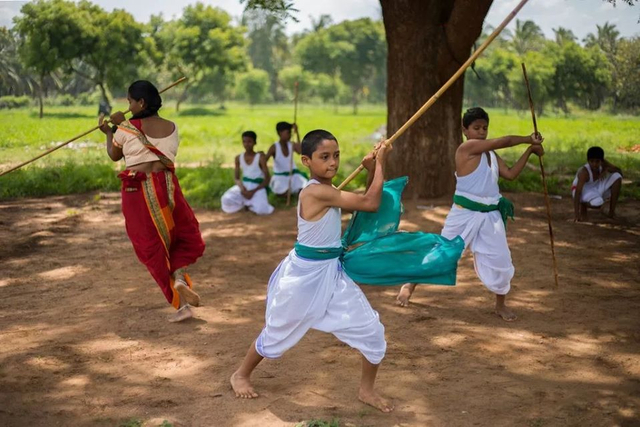Exploring the Art and Heritage of Silambam: Indian Stick Fighting

Silambam, an ancient Indian martial art, has a rich history that dates back several centuries. Rooted in the southern state of Tamil Nadu, Silambam is a traditional martial art form that focuses on the use of sticks as weapons and is also known for its elaborate and rhythmic movements. This unique art form has not only preserved its historical significance but continues to be practiced and appreciated by enthusiasts and martial artists around the world.
Origins and History:
The origins of Silambam can be traced back to the southern regions of India, particularly Tamil Nadu and Kerala. It is believed to have been practiced for over 2,000 years and is closely associated with the ancient Sangam period of Tamil history, which existed between 300 BC and 300 AD.
The name “Silambam” itself is derived from the Tamil word “Silam,” which means “hill” or “mountain,” and “Ambu,” which means “arrow.” This name is a reflection of the art’s historical significance, where sticks were used both as weapons and as tools for hunting in hilly terrains.
Silambam Techniques:
Silambam is distinct for its intricate techniques and forms, which involve the use of sticks in various ways. The primary weapon in Silambam is the “Silambam staff,” a long stick made from various materials, often chosen for their flexibility, durability, and weight. The length of the staff typically varies from practitioner to practitioner, with a general rule being that it should measure from the ground to the practitioner’s armpit.
Key weapons in Silambam:
Silambam incorporates a variety of weapons and equipment, each serving a specific purpose in the practice and training of this art. Here are some of the key weapons and equipment used in Silambam:
Silambam Staff (Silambattam): The primary weapon in Silambam is the staff, also known as the “Silambam stick” or “Silambattam.” It is a long cylindrical stick made from materials like bamboo, rattan, or other hardwoods. The length of the staff can vary based on the practitioner’s height and preference but typically ranges from the ground to the practitioner’s armpit.
Yerikkaiparam: This is a short stick or baton, often made from wood, that is used as a secondary weapon in Silambam. It is typically held in the off-hand to assist in defense or as a secondary striking weapon.
Kodi Kambu (Flagpole): A pole topped with a flag or decorative finial. It can be used as a training tool to develop wrist and arm strength and control in striking and spinning techniques.
Maan Kombu (Deer Horn Knives): These are two curved knives shaped like a deer’s horns. While not as commonly used as the staff, they are occasionally integrated into Silambam for advanced practitioners, primarily for dual-wielding techniques.
Maru Kombu (Metal Rods): Maru Kombu are short metal rods used for striking and self-defense. They are not traditionally part of Silambam but can be incorporated into some modern variations of the art.
Karambit: A small, curved blade with a handle, often used in Filipino martial arts. It is sometimes incorporated into Silambam techniques.
Sword and Shield: Although not typical Silambam weapons, some practitioners combine Silambam techniques with sword and shield techniques, demonstrating versatility and adaptability.
Bullwhip: In some modern interpretations, the bullwhip is used for its precision and dexterity in striking and control.
Philosophy and Training
Silambam is not just about physical combat; it also emphasizes discipline, focus, and self-control. Practitioners often adhere to a code of ethics that promotes respect for one’s opponent and the art itself. Training in Silambam is rigorous and demanding, involving a combination of physical conditioning, techniques, and weapon handling. Additionally, meditation and breath control are also important aspects of Silambam training.
Benefits of Silambam:
Strength and Endurance: Silambam training involves rigorous movements and exercises that help develop muscular strength and endurance, particularly in the upper body.
Flexibility: Practicing Silambam requires a wide range of motion, which helps improve flexibility and agility.
Cardiovascular Health: The fast-paced, rhythmic nature of Silambam training provides an excellent cardiovascular workout, helping to improve heart health and stamina.
Balance and Coordination: The art’s intricate movements and techniques improve balance, coordination, and body control.
Weight Management: Regular practice of Silambam can help with weight management and overall fitness.
Silambam Today:
In recent years, Silambam has gained recognition beyond its traditional roots. It has found its way into the global martial arts community, with practitioners and enthusiasts from different countries showing interest in this unique and ancient martial art. Various organizations and associations have been established to preserve and promote Silambam, organizing competitions, workshops, and seminars to spread awareness and maintain its legacy.
Epilogue:
Silambam, the ancient Indian art of stick fighting, offers a fascinating glimpse into the rich martial heritage of the Tamil Nadu region. Its intricate techniques, deep-rooted philosophy, and cultural significance make it a valuable asset in the world of martial arts. As it continues to evolve and gain popularity on a global scale, Silambam serves as a testament to the enduring appeal of traditional martial arts. Whether you’re an aspiring martial artist or simply interested in exploring the cultural aspects of India, Silambam is a treasure worth discovering.
